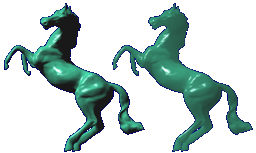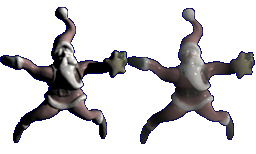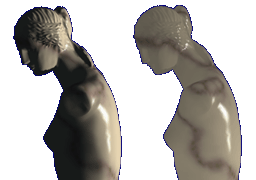
| Interactive Subsurface
Scattering for Translucent Meshes Xuejun Hao, Thomas Baby, and Amitabh Varshney |
We propose a simple lighting model to incorporate subsurface scattering effects within the local illumination framework to enable the interactive rendering of translucent materials. Based on the observation that subsurface scattering is relatively local due to its exponential falloff, we approximate the BSSRDF model and to model subsurface scattering effects by using only local illumination. After pre-computing the neighborhood information as sets of integrals at preprocessing stage, we are able to bleed in the scattering effects from a vertex's neighborhood to produce the final appearance at minimum cost. Our run-time algorithm has an efficient O(N) complexity, where N is the number of vertices. Using this approach, we achieve interactive frame rates with about one to two orders of magnitude speedup compared with the state-of-the-art methods.
| Motivation |
Photo-realistic image synthesis remains one of the primary goals of graphics. To achieve this, it is necessary to model the interaction of light with objects in a physically correct manner. Most illumination models give the bidirectional reflectance distribution function (BRDF). The basic assumption that light enters and exits the object surface at the same point for BRDF models is not always valid. As an example, BRDF is inadequate translucent materials, such as marble, skin, milk, etc. For simulating the appearance of these materials, we need the more general bidirectional surface scattering reflectance distribution function (BSSRDF).
To simulate the BSSRDF to a full extent using either radiance transfer, or Monte Carlo simulation, or path tracing will be too slow for interactive rendering. We intend to integrate the subsurface scattering into the local illumination framework and enable the interactive rendering of subsurface scattering effects.
| Contributions |
Our approach approximates the BSSRDF for subsurface scattering based on both, the underlying physical processes and the visual appearance. As the multiple scattering events dominate the single scattering events for the appearance of translucent materials, the focus is only on the multiple scattering events. Our approach captures the most important features of subsurface scattering: multiple scattering reflection and transmission, and can generate visually appealing images interactively. The main contributions of this research are:
We show that it is possible to incorporate subsurface scattering effects into a local illumination model, which makes it easy and efficient to simulate the phenomena in many applications.
We provide, with reasons, methods to approximate the main features of subsurface scattering, i.e., reflection and transmission due to multiple scattering, for generating realistic visual effects.
We show how to incorporate subsurface scattering into a run-time single-stage local illumination process to improve the complexity of the run-time algorithm from O(N2) to O(N) and achieve interactive frame rates for simulating translucent materials.
| Results |
We demonstrate our simplified subsurface scattering model by showing the visual effects we can generate on polygonal datasets. Our model can generate images for datasets with more than one million triangles within a few tenths of a second, and achieve interactive frame rates for models with about 300K triangles. It runs about 50 times faster than the state-of-the-art approaches. Our algorithm is only about 30% slower compared with local illumination without subsurface scattering. This small overhead will give most applications the opportunity to include the subsurface scattering effects for more photo-realistic rendering without sacrificing the interactive frame rates. The following table shows the results of our algorithm.
Model Name Noumber of Vertices
Number of Triangles
Frame rate (fps) with scattering without scattering Horse 14,521 29,054 69.3 98.2 Venus 42,656 90,044 23.4 33.9 Santa 75,781 151,558 12.7 17.2 Teapot 150,510 292,168 7.5 10.6 Dragon 437,645 871,414 2.4 3.4 Buddha 543,652 1,087,716 1.9 2.8
| Conclusions |
We have shown that the subsurface scattering effects for translucent materials can be simulated efficiently within the local illumination framework. The algorithm delivers about one to two orders of magnitude speedup over the previous approaches simulating the subsurface scattering effect. The results capture the most important effects of subsurface scattering, such as neighborhood bleeding and smooth transitions between regions separated by sharp edges. Our approach, by a little modification, can also be incorporated into shadow algorithms to generate soft shadow effects.
| Publications |
- X. Hao, T. Baby and A. Varshney, Interactive Subsurface Scattering for Translucent Meshes, ACM Symposium on Interactive 3D Graphics 2003, pp 75 - 82
- X. Hao and A. Varshney, Real-Time Rendering of Translucent Meshes, ACM Transactions on Graphics , Vol 23, No 2, April 2004, pp 120 - 142
| Acknowledgements |
We would like to thank Henrik Wann Jensen, Pat Hanrahan, and Juan Buhler for providing the lighting and material parameters.
This material is based upon work supported by the National Science Foundation under grants ACR-98-12572 and IIS-00-81847.Any opinions, findings, and conclusions or recommendations expressed in this material are those of the author(s) and do not necessarily reflect the views of the National Science Foundation.







